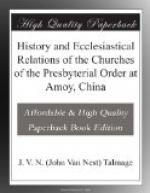“We are hopeful, however, that on further consideration, our brethren in America may allow their Missionaries in China to continue the present arrangement, at least until such time as it is found that actual difficulties arise in the way of carrying it out. ’Behold how good and how pleasant it is for brethren to dwell together in unity;’ and there are few brethren towards whom we feel closer affinity than the members of that Church, which was represented of old by Gomarus and Witsius, by Voet and Marck, and Bernard de Moore, and whose Synod of Dort preceded in time, and pioneered in doctrine, our own Westminster Assembly. Like them, we love that Presbyterianism and that Calvinism which we hold in common, and we wish to carry them wherever we go; but we fear that it would not be doing justice to either, and that it might compromise that name which is above every other, if, on the shores of China, we were to unfurl a separate standard. We would, therefore, not only respectfully recommend to the Synod to allow its Missionaries to unite, Presbyterially as well as practically, with the brethren of the R.D.C.; but we would express the earnest hope that the Synod of the sister Church in America may find itself at liberty to extend to its Missionaries a similar freedom.”
These sentiments were unanimously adopted by the Synod of the English Presbyterian Church.
It seems perfectly reasonable that two Churches of Christ so nearly alike, in attempting to plant the Church of Christ in the same place in a heathen land, should strive, if possible, to form their converts into one organization. The existence of different Denominations in the same place in any Christian land, at the best, is only a necessary evil. God may bring some good out of this evil, but this is not a sufficient reason why we should create such divisions, for their own sake. Hence, the liberality of the English Presbyterian Church is so manifestly in accordance with the Christian spirit, that it might have attracted no especial notice from us. But the proceedings of our own Synod, by contrast, as it seems to us, have forced it out in bold relief. They were willing to support their Missionaries in laboring with ours, and building up a Chinese Church, not differing essentially from theirs, but with some characteristics peculiar to ours. We, though the Church thus organized has not only all the essentials but all the peculiarities of our own Church, still refuse such Christian co-operation, preferring to rend asunder the Church already formed, and organize a part of it a distinct Denomination, connected with the Church in America. I cannot yet believe that such is the sentiment of our Church. There must be some great misapprehension. But such is really the decision of the last Synod. Here is the language of the Committee which was adopted by the General Synod:
“Your Committee do not see any propriety in re-enacting the law of 1857 already quoted, because it has never been repealed, and remains therefore in full force and virtue. Nor, if the reasoning in this report be correct, would they have the law repealed, believing as they do, that the maintenance of the principle contained in it is essential to the success of our Missionary operations in foreign parts, and to the wholesome liberality of the Church at home.




